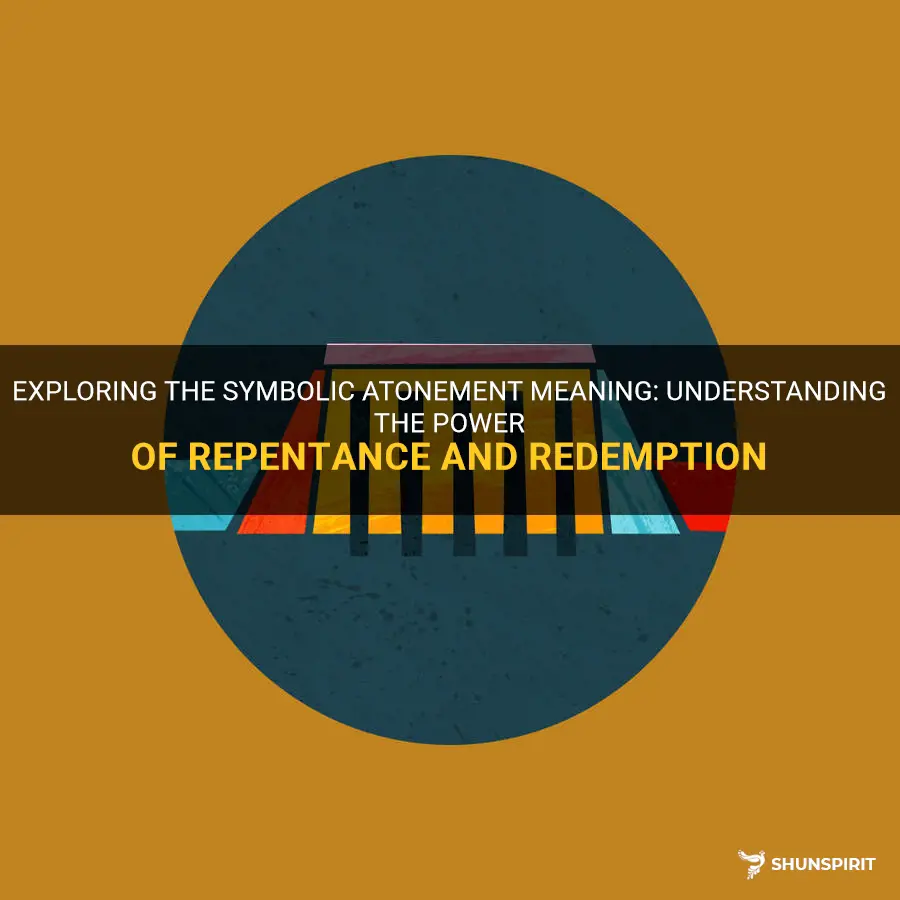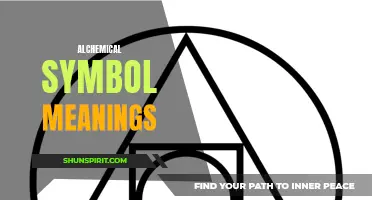
Symbolic atonement refers to the concept of seeking forgiveness and redemption through symbolic acts or rituals. It is deeply rooted in various cultures and religions across the world, serving as a powerful tool for individuals to reconcile with themselves and their communities. Whether it be through prayers, offerings, or self-sacrifice, symbolic atonement allows people to symbolically cleanse themselves of guilt, remorse, or past wrongdoings, and pave the way for personal growth, healing, and restoration. It is in these symbolic acts that the power of forgiveness and transformation becomes tangible, reminding us of the deep human need for redemption and the possibility of second chances.
What You'll Learn
- What is the symbolic meaning of atonement in religious traditions?
- How does symbolic atonement differ from literal atonement?
- What symbols are commonly associated with atonement in Christianity?
- How does symbolic atonement contribute to the overall narrative of redemption and forgiveness?
- Are there any other religious or cultural traditions that use symbolic atonement practices?

What is the symbolic meaning of atonement in religious traditions?
Atonement plays a crucial role in various religious traditions, representing a symbolic and powerful concept of reconciliation and redemption. From Christianity to Judaism and Islam, the idea of atonement provides a framework for individuals to seek forgiveness for their sins and restore their relationship with a higher power. Although the specifics may differ across religious traditions, the underlying symbolism of atonement remains consistent.
In Christianity, atonement is seen as the ultimate act of love and sacrifice, exemplified by Jesus Christ's death on the cross. According to Christian belief, humanity is inherently sinful, and the death of Jesus serves as a means to reconcile humanity with God. By willingly giving up his life, Jesus takes on the sins of all people, offering them forgiveness and allowing them to be reconciled with God. This act of atonement is seen as an expression of God's mercy and compassion, giving believers the opportunity to receive salvation and eternal life.
Similarly, in Judaism, atonement is a central concept in the observance of Yom Kippur, the Day of Atonement. On this holiest day of the Jewish calendar, individuals seek forgiveness for their sins through a process of self-reflection, repentance, and prayer. The act of atonement during Yom Kippur is symbolic of the journey towards spiritual renewal and purification. Through sincere repentance and the commitment to change one's ways, individuals aim to restore their relationship with God and their fellow human beings.
In Islam, the concept of atonement is closely tied to the idea of tawbah, which means repentance. Muslims view atonement as a mechanism to seek forgiveness from Allah and rectify one's actions. In Islam, the act of atonement involves recognizing and acknowledging one's mistakes, seeking forgiveness from God, and making amends. It is believed that true repentance can lead to spiritual growth and purification of the soul, ultimately bringing individuals closer to Allah.
The symbolic meaning of atonement in religious traditions extends beyond the act of seeking forgiveness. It represents an opportunity for personal transformation and a commitment to lead a more righteous and virtuous life. It serves as a reminder that humans are fallible and capable of making mistakes but can also learn from them and strive for spiritual growth. Atonement is a call for individuals to reflect upon their actions, make amends, and realign themselves with the principles, values, and teachings of their respective religious traditions.
In summary, atonement holds deep symbolic meaning in religious traditions. It represents a path to forgiveness, reconciliation, and redemption. Whether it is through Jesus' sacrifice in Christianity, the observance of Yom Kippur in Judaism, or the concept of tawbah in Islam, atonement serves as a powerful reminder of the capacity for individuals to seek forgiveness, transform their lives, and restore their relationship with a higher power. It is a symbolic journey towards spiritual renewal, purification, and the pursuit of righteousness.
The Captivating Symbolism of the Blue Heron: Exploring Its Meaning and Significance
You may want to see also

How does symbolic atonement differ from literal atonement?
Symbolic atonement and literal atonement are two different approaches to understanding the concept of atonement in various religious and spiritual traditions. While both concepts seek to address the idea of reconciling with a higher power or obtaining forgiveness for wrongdoing, they differ in their interpretations and practices.
Literal atonement refers to the belief that physical actions or rituals are necessary to achieve forgiveness or reconciliation. This could involve specific religious rituals, such as animal sacrifices, sacraments, or acts of penance. In literal atonement, the focus is on external actions that are believed to have a direct effect on one's relationship with a higher power. This approach emphasizes the importance of adhering to religious laws and regulations in order to obtain forgiveness and restore a person's spiritual alignment.
On the other hand, symbolic atonement refers to the idea that forgiveness and reconciliation are achieved through the symbolic interpretation of actions or rituals. This approach recognizes that the external actions themselves may not have a direct effect on one's relationship with a higher power. Instead, they serve as symbolic representations of a person's internal attitudes, intentions, and commitment to change. In symbolic atonement, the focus is on the internal transformation and the sincere repentance that accompanies the outward actions.
In symbolic atonement, the emphasis is placed on the individual's genuine contrition and the desire to make amends. The external actions or rituals are seen as vehicles for expressing this inner transformation rather than as means to secure forgiveness directly. By participating in symbolic acts, individuals are acknowledging their responsibility for their actions and their intent to rectify their mistakes.
One example of symbolic atonement is found in the religious practice of confession. In many traditions, individuals are encouraged to confess their sins or wrongdoing to a higher power, a religious authority, or even to those who have been harmed. This act of confession serves as a symbolic gesture of humility, accountability, and a genuine desire to seek forgiveness. It is not the act of confession itself that brings about forgiveness, but the sincere remorse and commitment to change that accompany it.
Symbolic atonement also recognizes that forgiveness and reconciliation may extend beyond the individual and involve the collective or community. It emphasizes the importance of repairing relationships, restoring harmony, and healing the wounds caused by wrongdoing. This can be accomplished through acts of restitution, reconciliation, and acts of service to others.
While both literal and symbolic atonement approaches have their place in various religious and spiritual traditions, they offer different perspectives on the nature of forgiveness and reconciliation. Literal atonement focuses on the external actions and their direct effect on one's relationship with a higher power, while symbolic atonement emphasizes the internal transformation, sincere remorse, and commitment to change that accompany genuine repentance. Ultimately, the choice between these approaches depends on the individual's beliefs, practices, and understanding of the concept of atonement in their specific religious or spiritual context.
Decoding the Mystery: Unveiling the Meaning Behind Microwave Symbols
You may want to see also

What symbols are commonly associated with atonement in Christianity?
In Christianity, atonement refers to the act of reconciling humanity with God through the sacrificial death of Jesus Christ on the cross. It is a central concept in the Christian faith, emphasizing the belief that Jesus' death absolves believers of their sins and allows them to have a restored relationship with God. Throughout Christian history, various symbols have been used to represent atonement and its significance. Let's explore some of the common symbols associated with atonement in Christianity.
- The Cross: The most recognizable symbol in Christianity, the cross represents Jesus' crucifixion, which is the ultimate act of atonement. Christians believe that Jesus' sacrificial death on the cross paid the price for humanity's sins and brought salvation to those who believe in Him. The cross serves as a powerful reminder of God's love and the atoning sacrifice made by Jesus.
- The Lamb: In Christianity, the lamb symbolizes Jesus as the "Lamb of God" who takes away the sins of the world. This imagery is derived from the Old Testament, where lambs were sacrificed as offerings for atonement. Jesus is considered the ultimate and perfect sacrificial lamb, whose death provided redemption for all humanity.
- Blood: The concept of blood is closely associated with atonement in Christianity. The shedding of Jesus' blood is seen as the means through which atonement and forgiveness of sins are achieved. The blood of Jesus is seen as the cleansing agent that washes away the guilt and stains of sin, allowing believers to be reconciled with God.
- The Chalice: The chalice, or cup, is often used as a symbol of atonement in Christian rituals, particularly in the sacrament of Holy Communion. The chalice represents the blood of Christ, which is shared among believers as a reminder of the atoning sacrifice made on their behalf.
- The Dove: In some Christian traditions, the dove is used as a symbol of atonement and the Holy Spirit. The dove represents peace, purity, and the presence of God. It is often associated with the baptism of Jesus, where the Holy Spirit descended on Him like a dove, symbolizing His role in the atonement of humanity.
- The Crown of Thorns: The crown of thorns is a powerful symbol of Jesus' suffering and the price He paid for atonement. According to the Gospel accounts, Jesus was mockingly crowned with thorns before His crucifixion. The crown of thorns serves as a reminder of the immense pain and sacrifice Jesus endured for the sake of humanity's salvation.
These symbols help Christians understand and reflect on the profound meaning of atonement in their faith. They serve as reminders of God's love, Jesus' sacrifice, and the hope of reconciliation with God that is made possible through Christ's atoning work.
The Hidden Meaning Behind the Acorn Symbol Unveiled
You may want to see also

How does symbolic atonement contribute to the overall narrative of redemption and forgiveness?
Symbolic atonement is a prevalent theme in literature and religious texts, and it often serves to contribute to the overall narrative of redemption and forgiveness. The concept of atonement refers to the act of making amends for a wrongdoing or sin, and symbolic atonement involves using a tangible or symbolic action or object to represent and fulfill this act of repentance.
In many narratives, the notion of redemption and forgiveness is a central theme. Characters are often burdened by guilt or past actions, and their journey towards redemption and forgiveness forms the backbone of the plot. Symbolic atonement serves as a powerful tool in these narratives, as it allows characters to physically and emotionally release themselves from the weight of their transgressions.
One way in which symbolic atonement contributes to the overall narrative is by providing a tangible representation of the character's internal journey. By acting out a physical symbol of repentance, the character is able to demonstrate their genuine desire to make amends. This can be seen in various religious rituals and practices, such as offering sacrifices or participating in specific ceremonies. These actions are not simply performed for the sake of tradition, but rather as a way for individuals to truly show their remorse and commitment to change.
Symbolic atonement can also serve as a catalyst for personal growth and transformation. Through the act of atonement, characters are often forced to confront their past actions and their impact on others. This self-reflection allows them to gain a deeper understanding of themselves and their role in the world. By acknowledging their wrongdoing and taking responsibility for it, characters are able to learn from their mistakes and evolve as individuals. This growth and transformation is essential for the overall narrative of redemption and forgiveness, as it demonstrates the character's ability to change and seek a better future.
Furthermore, symbolic atonement can act as a means of reconciliation and healing. By performing a symbolic act of repentance, characters are not only seeking forgiveness from others, but also from themselves. This internal healing is crucial in order for true redemption to occur. By releasing themselves from guilt and shame, characters are able to truly move forward and rebuild relationships that may have been damaged by their past actions. This process of reconciliation adds depth and complexity to the narrative, as it explores the dynamics of forgiveness and the power of healing.
In conclusion, symbolic atonement plays a vital role in the overall narrative of redemption and forgiveness. It provides a tangible representation of the character's internal journey, catalyzes personal growth and transformation, and allows for reconciliation and healing. Whether through religious rituals or symbolic acts, the concept of atonement serves to highlight the power of remorse, personal growth, and forgiveness. By engaging with symbolic atonement, characters are able to find redemption and forgiveness, contributing to a powerful and compelling narrative.
The Ultimate Guide to Rune Symbols and Meanings: Unlock the Secrets with an In-Depth Chart
You may want to see also

Are there any other religious or cultural traditions that use symbolic atonement practices?
Atonement is a concept present in many religious and cultural traditions around the world. It refers to the act of making reparations for wrongdoing or sins in order to achieve forgiveness or reconciliation. While the practice of atonement varies greatly between different belief systems, there are several other religious and cultural traditions that use symbolic atonement practices similar to those found in Christianity and Judaism.
One such example is found in the Islamic tradition, where atonement is known as "kaffara." In Islam, kaffara refers to the act of making amends for offenses committed against God or others. This might involve various forms of repentance, such as fasting, making charitable donations, or performing specific prayers. Kaffara is seen as a way to purify oneself and seek forgiveness for one's sins.
In Hinduism, there is a concept known as "prayaschitta," which can be understood as a form of atonement. Prayaschitta is the act of repentance and purification in order to attain forgiveness and restore spiritual purity. This can involve various rituals, such as bathing in sacred rivers, reciting prayers or mantras, or making offerings to deities. The purpose of these practices is to cleanse oneself of impurities and achieve reconciliation with the divine.
In some Native American traditions, atonement practices are also present. For example, among the Lakota Sioux, there is a ritual known as the "Hanbleceya" or vision quest. This is a form of atonement and spiritual initiation, where individuals seek guidance and purification by spending time alone in nature, fasting, and praying. The vision quest is seen as a way to connect with the spiritual realm and receive guidance and forgiveness for past actions.
Buddhism, too, has its own practices of atonement. In some Buddhist traditions, there are ceremonies known as "gye ba" or confession rituals. These ceremonies involve acknowledging and taking responsibility for one's actions, repenting sincerely, and making a vow to avoid harmful behaviors in the future. The purpose of these confession rituals is to purify one's mind and attain spiritual growth.
In conclusion, symbolic atonement practices can be found in various religious and cultural traditions around the world. Whether it is through fasting, praying, making offerings, or engaging in rituals, these practices serve as a means of seeking forgiveness, purifying oneself, and restoring harmony with the divine. While the specific rituals and beliefs may vary, the underlying concept of atonement remains a universal aspect of human spirituality.
Unveiling the Symbolic Depths: Exploring the Meaning of Oil in the Bible
You may want to see also
Frequently asked questions
Symbolic atonement refers to the concept of seeking forgiveness or making amends through the use of symbols or symbolic actions. It is a way to express remorse, acknowledge wrongdoing, and signify a commitment to change or make things right.
Unlike traditional forms of atonement, which often involve direct actions or reparations to those who have been harmed, symbolic atonement focuses on using symbolic gestures or acts to convey remorse and express a desire for reconciliation or forgiveness. It is more about the intention and symbolism behind the actions rather than the direct impact on the individuals involved.
Examples of symbolic atonement can vary greatly depending on the context and the nature of the wrongdoing. It can include actions such as public apologies or statements, participation in symbolic rituals or ceremonies, making donations to relevant causes, or engaging in acts of service or restitution. The specific actions taken should ideally be meaningful and relevant to the harm caused and the desire for reconciliation.
Symbolic atonement can be a powerful tool in initiating the process of forgiveness and reconciliation, but its effectiveness ultimately depends on the willingness of those who have been harmed to accept and engage with the symbolic gestures. It is important to recognize that symbolic atonement alone may not be enough to fully repair relationships or heal the wounds caused by wrongdoing, but it can be a meaningful step towards that end.
Engaging in symbolic atonement starts with introspection and reflecting on one's actions and the harm caused. From there, it involves identifying meaningful and relevant symbolic gestures or actions that express remorse and a commitment to change. It is important to approach symbolic atonement with sincerity, humility, and a genuine desire for reconciliation. Engaging in open and honest communication with those affected by the wrongdoing can also be instrumental in finding appropriate ways to engage in symbolic atonement.







